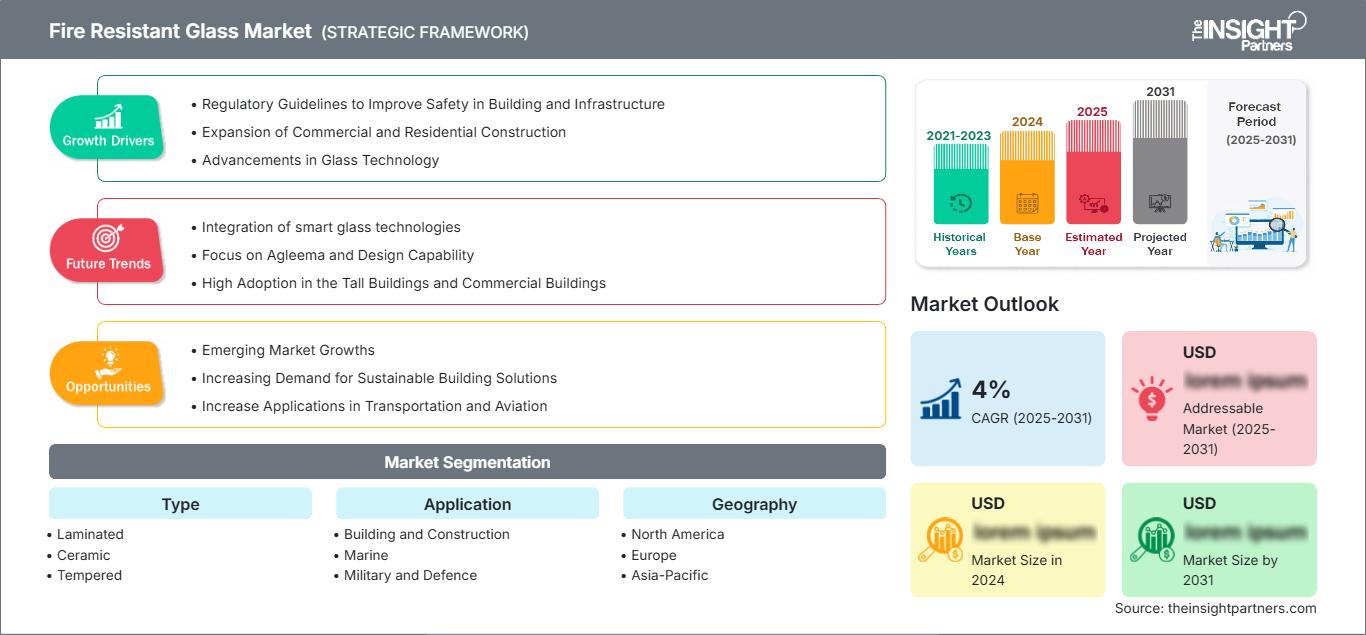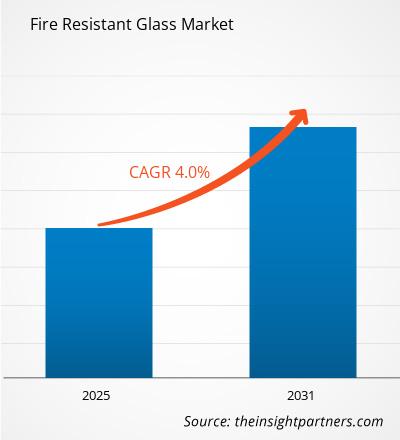Fire Resistant Glass Market Key Players Analysis, and Growth Forecast by 2031
Historic Data: 2021-2023 | Base Year: 2024 | Forecast Period: 2025-2031Coverage: Fire Resistant Glass Market covers analysis By Type (Laminated, Ceramic, Tempered, and Wired) and Application (Building & Construction, Marine, Military & Defence, and others)
- Report Date : Mar 2026
- Report Code : TIPMC00002739
- Category : Chemicals and Materials
- Status : Upcoming
- Available Report Formats :


- No. of Pages : 150
The Fire Resistant Glass Market size is expected to reach US$ 17.31 billion by 2031. The market is anticipated to register a CAGR of 8.8% during 2025-2031.
Fire Resistant Glass Market covers analysis By Type (Laminated, Ceramic, Tempered, and Wired) and Application (Building and Construction, Marine, Military and Defence, and others), and Geography (North America, Europe, Asia Pacific, Middle East and Africa, and South and Central America). Fire-resistant glass is a crucial safety feature in construction. The market has seen growth due to increasing awareness regarding fire safety. There are numerous advantages, such as thermal resistance, shatter resistance, high impact safety, sound reduction, and others. In recent years, fire-resistance glass has been widely adopted as a safer replacement for conventional glass.
Purpose of the Report
The report Fire Resistant Glass Market by The Insight Partners aims to describe the present landscape and future growth, top driving factors, challenges, and opportunities. This will provide insights to various business stakeholders, such as:
- Technology Providers/Manufacturers: To understand the evolving market dynamics and know the potential growth opportunities, enabling them to make informed strategic decisions.
- Investors: To conduct a comprehensive trend analysis regarding the market growth rate, market financial projections, and opportunities that exist across the value chain.
- Regulatory bodies: To regulate policies and police activities in the market with the aim of minimizing abuse, preserving investor trust and confidence, and upholding the integrity and stability of the market.
Fire Resistant Glass Market Segmentation Type
- Laminated
- Ceramic
- Tempered
- Wired
Application
- Building and Construction
- Marine
- Military and Defence
You will get customization on any report - free of charge - including parts of this report, or country-level analysis, Excel Data pack, as well as avail great offers and discounts for start-ups & universities
Fire Resistant Glass Market: Strategic Insights

-
Get Top Key Market Trends of this report.This FREE sample will include data analysis, ranging from market trends to estimates and forecasts.
Fire Resistant Glass Market Growth Drivers
- Regulatory Guidelines to Improve Safety in Building and Infrastructure: Increased fire safety regulation concerning the construction and infrastructure projects results in the demand for fire-resistant glass. With enacting stringent building codes, fire-resistant glass is increasingly required as windows, doors, and partitions that comply with safety standards and further provide the level of fire protection desired in commercial and residential buildings.
- Expansion of Commercial and Residential Construction:This development is a notable driving force for the market of fire-resistant glass in the increase of construction activities, including commercial and residential areas, around the world. Fire-rated glazing is opted for by builders and architects to ensure safety, durability, and building compliance with fire protection regulations, creating a continuous demand for construction industries now and in the future.
- Advancements in Glass Technology: Technology is improving the performance and aesthetics of fire-protective glass. Furthermore, the introduction of multi-layer and insulated glass provides excellent fire-resistant properties along with enhanced aesthetics and acoustic insulation, thereby expanding the application of fire-protective glass, particularly for high-rise buildings, public venues, and industry sectors.
Fire Resistant Glass Market Future Trends
- Integration of smart glass technologies: The new entrants in the glass market have to do with the integration of smart glass technologies into the fire-resistant glass areas. These types of advanced glass have a special quality in the sense that they automatically adjust their transparency for improving energy and comfort requirements with the fire resistance as well. This added feature of smartness has imperative use in commercial applications, to come into modern residential projects, office fittings, and so on.
- Focus on Agleema and Design Capability: Safety, comfort, and aesthetic appeal are very great trends in fire-resistant glass. Commonly architects and builders want glass solutions designed such that the appearance of modern designs blends smoothly into the overall picture with transparency and aesthetic value but meeting highly valued fire protection standards.
- High Adoption in the Tall Buildings and Commercial Buildings: Fire-resistant glass is well suited to the increasing number of high-rise structures as the condition becomes urban. The taller buildings need stronger safety measures, given that fire-resistant glass is used for facades, different divisions of space, and windows in both safety and beautiful purposes.
Fire Resistant Glass Market Opportunities
- Emerging Market Growths: As one of the requests, the fire-resistant glass should be added due to the expansion of emerging economies. Urbanization is definitely expected to bring about further regulations when it comes to buildings, and towards the construction of fire-resistance-the-parole glass products, many opportunities are created in Asia and Africa, for instance, in the form of residential, commercial, and industrial buildings.
- Increasing Demand for Sustainable Building Solutions: Increasing attention being directed towards sustainable construction has created a growing market for fire-resistant insulating and energy-efficient glazing products. With this trend, many possibilities for manufacturers could arise through the provision of eco-friendly, energy-efficient fire-resistant glazing solutions that meet fire safety standards and also make the grade demanded by the developers of green buildings.
- Increase Applications in Transportation and Aviation: The locomotive and aircraft worlds are taking a more receptive attitude toward fire-protected acrylic. There is demand for them in those fields by high-speed trains and aircraft carriers requiring high temperatures, visibility, and safety conditions for the glass. By the expansion of air and rail travel unit, opportunities in these markets are also expected to continue increasing.
The regional trends and factors influencing the Fire Resistant Glass Market throughout the forecast period have been thoroughly explained by the analysts at The Insight Partners. This section also discusses Fire Resistant Glass Market segments and geography across North America, Europe, Asia Pacific, Middle East and Africa, and South and Central America.
Fire Resistant Glass Market Report Scope
| Report Attribute | Details |
|---|---|
| Market size in 2024 | US$ XX Billion |
| Market Size by 2031 | US$ 17.31 billion |
| Global CAGR (2025 - 2031) | 8.8% |
| Historical Data | 2021-2023 |
| Forecast period | 2025-2031 |
| Segments Covered |
By Type
|
| Regions and Countries Covered |
North America
|
| Market leaders and key company profiles |
|
Fire Resistant Glass Market Players Density: Understanding Its Impact on Business Dynamics
The Fire Resistant Glass Market is growing rapidly, driven by increasing end-user demand due to factors such as evolving consumer preferences, technological advancements, and greater awareness of the product's benefits. As demand rises, businesses are expanding their offerings, innovating to meet consumer needs, and capitalizing on emerging trends, which further fuels market growth.

- Get the Fire Resistant Glass Market top key players overview
Key Selling Points
- Comprehensive Coverage: The report comprehensively covers the analysis of products, services, types, and end users of the Fire Resistant Glass Market, providing a holistic landscape.
- Expert Analysis: The report is compiled based on the in-depth understanding of industry experts and analysts.
- Up-to-date Information: The report assures business relevance due to its coverage of recent information and data trends.
- Customization Options: This report can be customized to cater to specific client requirements and suit the business strategies aptly.
The research report on the Fire Resistant Glass Market can, therefore, help spearhead the trail of decoding and understanding the industry scenario and growth prospects. Although there can be a few valid concerns, the overall benefits of this report tend to outweigh the disadvantages.
Frequently Asked Questions
Based on geography, which region is expected to record a highest CAGR in the market.
Which type segment accounted for the highest share in the fire resistant glass market?
What are the key players operating in the fire resistant glass market?
What are the driving factors impacting the fire resistant glass market?
What is the expected CAGR of the Fire Resistant Glass Market ?
What are the future trends in the market?
Habi is a seasoned Market Research Analyst with 8 years of experience specializing in the Chemicals and Materials sector, with additional expertise in the Food & Beverages and Consumer Goods industries. He is a Chemical Engineer from Vishwakarma Institute of Technology (VIT) and has developed deep domain knowledge across industrial and specialty chemicals, paints and coatings, paper and packaging, lubricants, and consumer products. Habi’s core competencies include market sizing and forecasting, competitive benchmarking, trend analysis, client engagement, report writing, and team coordination—making him adept at delivering actionable insights and supporting strategic decision-making.
- Historical Analysis (2 Years), Base Year, Forecast (7 Years) with CAGR
- PEST and SWOT Analysis
- Market Size Value / Volume - Global, Regional, Country
- Industry and Competitive Landscape
- Excel Dataset
Related Reports
Testimonials
The Insight Partners' SCADA System Market report is comprehensive, with valuable insights on current trends and future forecasts. The team was highly professional, responsive, and supportive throughout. We are very satisfied and highly recommend their services.
RAN KEDEM Partner, Reali Technologies LTDsI requested a report on a very specific software market and the team produced the report in a few days. The information was very relevant and well presented. I then requested some changes and additions to the report. The team was again very responsive and I got the final report in less than a week.
JEAN-HERVE JENN Chairman, Future AnalyticaWe worked with The Insight Partners for an important market study and forecast. They gave us clear insights into opportunities and risks, which helped shape our plans. Their research was easy to use and based on solid data. It helped us make smart, confident decisions. We highly recommend them.
PIYUSH NAGPAL Sr. Vice President, High Beam GlobalThe Insight Partners delivered insightful, well-structured market research with strong domain expertise. Their team was professional and responsive throughout. The user-friendly website made accessing industry reports seamless. We highly recommend them for reliable, high-quality research services
YUKIHIKO ADACHI CEO, Deep Blue, LLC.This is the first time I have purchased a market report from The Insight Partners.While I was unsure at first, I visited their web site and felt more comfortable to take the risk and purchase a market report.I am completely satisfied with the quality of the report and customer service. I had several questions and comments with the initial report, but after a couple of dialogs over email with their analyst I believe I have a report that I can use as input to our strategic planning process.Thank you so much for taking the extra time and making this a positive experience.I will definitely recommend your service to others and you will be my first call when we need further market data.
JOHN SUZUKI President and Chief Executive Officer, Board Director, BK TechnologiesI wish to appreciate your support and the professionalism you displayed in the course of attending to my request for information regarding to infectious disease IVD market in Nigeria. I appreciate your patience, your guidance, and the fact that you were willing to offer a discount, which eventually made it possible for us to close a deal. I look forward to engaging The Insight Partners in the future, all thanks to the impression you have created in me as a result of this first encounter.
DR CHIJIOKE ONYIA MANAGING DIRECTOR, PineCrest Healthcare Ltd.Reason to Buy
- Informed Decision-Making
- Understanding Market Dynamics
- Competitive Analysis
- Identifying Emerging Markets
- Customer Insights
- Market Forecasts
- Risk Mitigation
- Boosting Operational Efficiency
- Strategic Planning
- Investment Justification
- Tracking Industry Innovations
- Aligning with Regulatory Trends




















 Get Free Sample For
Get Free Sample For